2014 BMW 5 SERIES GRAN TURISMO inflation pressure
[x] Cancel search: inflation pressurePage 191 of 259

LoadingVehicle features and options
This chapter describes all standard, country-
specific and optional features offered with the
series. It also describes features that are not
necessarily available in your car, e. g., due to
the selected options or country versions. This
also applies to safety-related functions and
systems.
Hints Overloading the vehicle
To avoid exceeding the approved ca‐
pacity of the tires, never overload the vehicle.
Overloading can lead to overheating and in‐
creases the rate at which damage develops in‐
side the tires. This could result in a sudden
loss of tire inflation pressure.◀
No fluids in the cargo area
Make sure that fluids do not leak into the
cargo area; otherwise, the vehicle may be dam‐
aged.◀
Heavy and hard objects
Do not stow any heavy and hard objects
in the car's interior without securing them; oth‐
erwise, they may present a danger to occu‐
pants, e.g., during braking and evasive maneu‐
vers.◀
Determining the load limit1.Locate the following statement on your ve‐
hicle’s placard:▷The combined weight of occupants
and cargo should never exceed XXX kg
or YYY lbs. Otherwise, damage to thevehicle and unstable driving situations
may result.2.Determine the combined weight of the
driver and passengers that will be riding in
your vehicle.3.Subtract the combined weight of the driver
and passengers from XXX kilograms or
YYY pounds.4.The resulting figure equals the available
amount of cargo and luggage load ca‐
pacity.
For example, if the YYY amount equals
1,000 lbs and there will be four 150 lbs
passengers in your vehicle, the amount of
available cargo and luggage load capacity
is 400 lbs: 1,000 lbs minus 600 lbs =
400 lbs.5.Determine the combined weight of lug‐
gage and cargo being loaded on the vehi‐
cle. That weight may not safely exceed the
available cargo and luggage load capacity
calculated in Step 4.Seite 187LoadingDriving tips187
Online Edition for Part no. 01 40 2 956 191 - X/14
Page 194 of 259
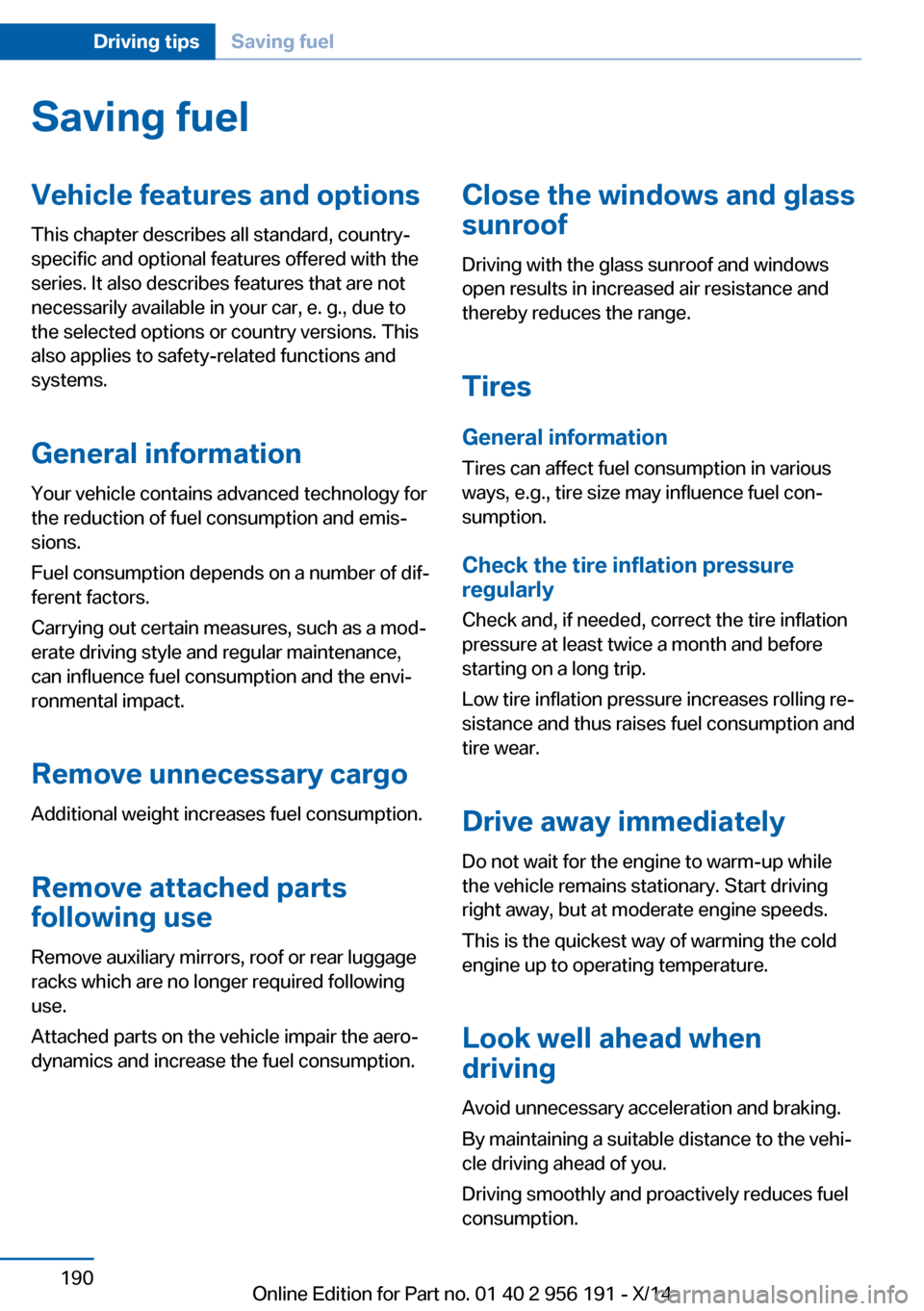
Saving fuelVehicle features and optionsThis chapter describes all standard, country-
specific and optional features offered with the
series. It also describes features that are not
necessarily available in your car, e. g., due to
the selected options or country versions. This
also applies to safety-related functions and
systems.
General information
Your vehicle contains advanced technology for
the reduction of fuel consumption and emis‐
sions.
Fuel consumption depends on a number of dif‐
ferent factors.
Carrying out certain measures, such as a mod‐
erate driving style and regular maintenance,
can influence fuel consumption and the envi‐
ronmental impact.
Remove unnecessary cargoAdditional weight increases fuel consumption.
Remove attached parts
following use
Remove auxiliary mirrors, roof or rear luggage
racks which are no longer required following
use.
Attached parts on the vehicle impair the aero‐
dynamics and increase the fuel consumption.Close the windows and glass
sunroof
Driving with the glass sunroof and windows
open results in increased air resistance and
thereby reduces the range.
Tires
General information Tires can affect fuel consumption in various
ways, e.g., tire size may influence fuel con‐
sumption.
Check the tire inflation pressure
regularly
Check and, if needed, correct the tire inflation
pressure at least twice a month and before
starting on a long trip.
Low tire inflation pressure increases rolling re‐
sistance and thus raises fuel consumption and
tire wear.
Drive away immediately
Do not wait for the engine to warm-up while
the vehicle remains stationary. Start driving
right away, but at moderate engine speeds.
This is the quickest way of warming the cold
engine up to operating temperature.
Look well ahead when
driving
Avoid unnecessary acceleration and braking.
By maintaining a suitable distance to the vehi‐
cle driving ahead of you.
Driving smoothly and proactively reduces fuel
consumption.Seite 190Driving tipsSaving fuel190
Online Edition for Part no. 01 40 2 956 191 - X/14
Page 206 of 259
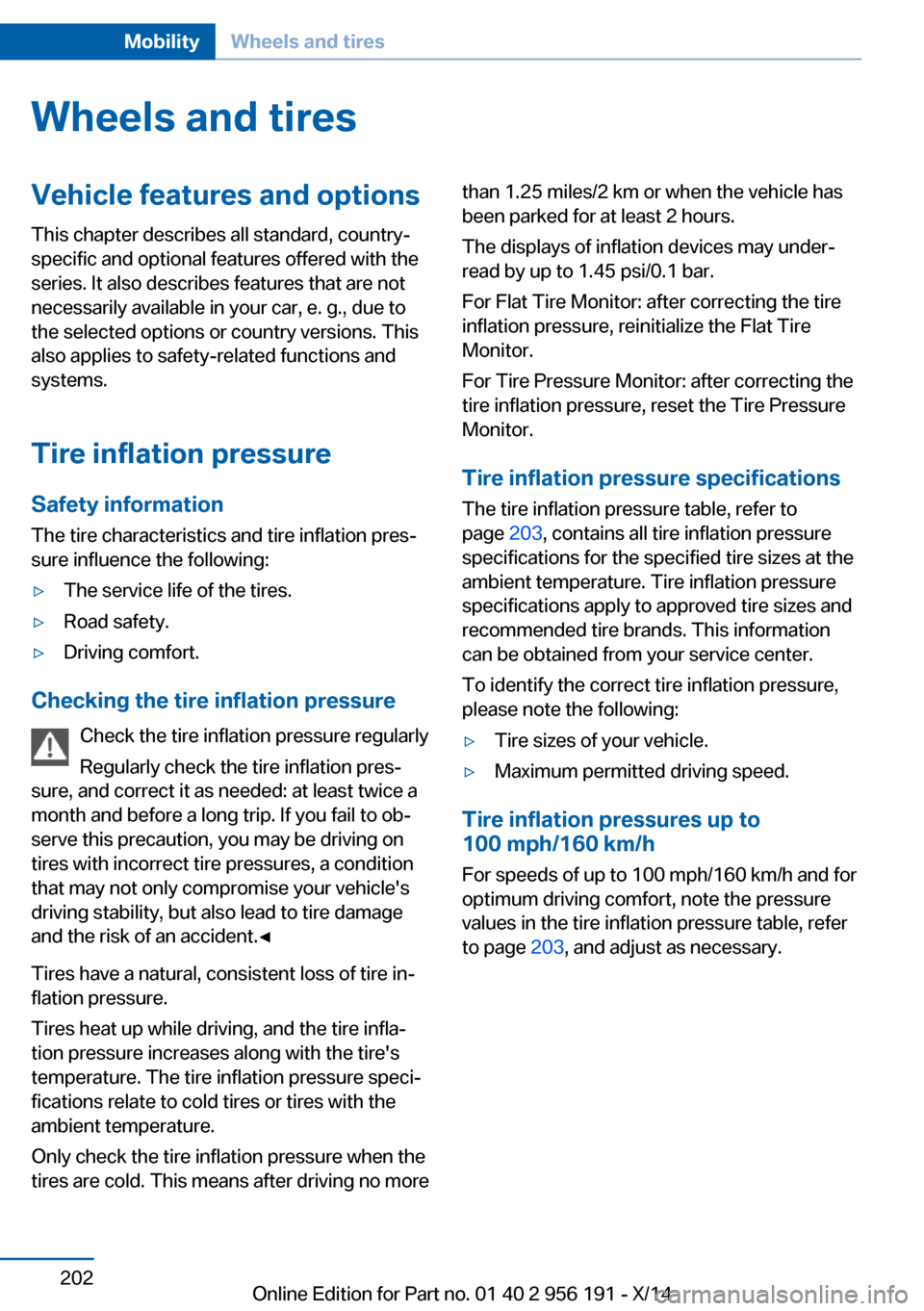
Wheels and tiresVehicle features and options
This chapter describes all standard, country-
specific and optional features offered with the
series. It also describes features that are not
necessarily available in your car, e. g., due to
the selected options or country versions. This
also applies to safety-related functions and
systems.
Tire inflation pressure
Safety information
The tire characteristics and tire inflation pres‐
sure influence the following:▷The service life of the tires.▷Road safety.▷Driving comfort.
Checking the tire inflation pressure
Check the tire inflation pressure regularly
Regularly check the tire inflation pres‐
sure, and correct it as needed: at least twice a
month and before a long trip. If you fail to ob‐
serve this precaution, you may be driving on
tires with incorrect tire pressures, a condition
that may not only compromise your vehicle's
driving stability, but also lead to tire damage
and the risk of an accident.◀
Tires have a natural, consistent loss of tire in‐
flation pressure.
Tires heat up while driving, and the tire infla‐
tion pressure increases along with the tire's
temperature. The tire inflation pressure speci‐
fications relate to cold tires or tires with the
ambient temperature.
Only check the tire inflation pressure when the
tires are cold. This means after driving no more
than 1.25 miles/2 km or when the vehicle has
been parked for at least 2 hours.
The displays of inflation devices may under-
read by up to 1.45 psi/0.1 bar.
For Flat Tire Monitor: after correcting the tire
inflation pressure, reinitialize the Flat Tire
Monitor.
For Tire Pressure Monitor: after correcting the
tire inflation pressure, reset the Tire Pressure
Monitor.
Tire inflation pressure specifications
The tire inflation pressure table, refer to
page 203, contains all tire inflation pressure
specifications for the specified tire sizes at the
ambient temperature. Tire inflation pressure
specifications apply to approved tire sizes and
recommended tire brands. This information
can be obtained from your service center.
To identify the correct tire inflation pressure,
please note the following:▷Tire sizes of your vehicle.▷Maximum permitted driving speed.
Tire inflation pressures up to
100 mph/160 km/h
For speeds of up to 100 mph/160 km/h and for
optimum driving comfort, note the pressure
values in the tire inflation pressure table, refer
to page 203, and adjust as necessary.
Seite 202MobilityWheels and tires202
Online Edition for Part no. 01 40 2 956 191 - X/14
Page 207 of 259
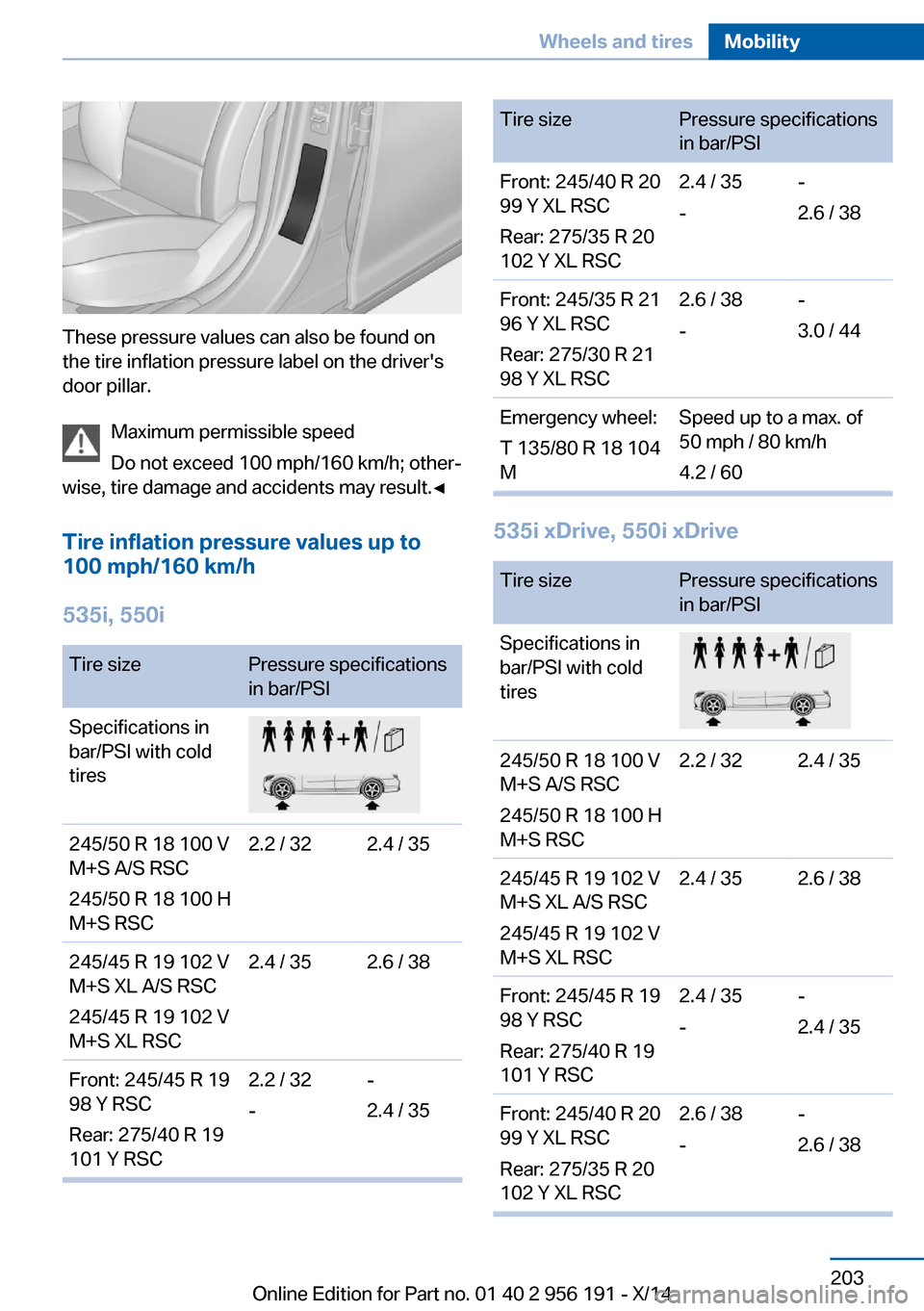
These pressure values can also be found on
the tire inflation pressure label on the driver's
door pillar.
Maximum permissible speed
Do not exceed 100 mph/160 km/h; other‐
wise, tire damage and accidents may result.◀
Tire inflation pressure values up to
100 mph/160 km/h
535i, 550i
Tire sizePressure specifications
in bar/PSISpecifications in
bar/PSI with cold
tires245/50 R 18 100 V
M+S A/S RSC
245/50 R 18 100 H
M+S RSC2.2 / 322.4 / 35245/45 R 19 102 V
M+S XL A/S RSC
245/45 R 19 102 V
M+S XL RSC2.4 / 352.6 / 38Front: 245/45 R 19
98 Y RSC
Rear: 275/40 R 19
101 Y RSC2.2 / 32
--
2.4 / 35Tire sizePressure specifications
in bar/PSIFront: 245/40 R 20
99 Y XL RSC
Rear: 275/35 R 20
102 Y XL RSC2.4 / 35
--
2.6 / 38Front: 245/35 R 21
96 Y XL RSC
Rear: 275/30 R 21
98 Y XL RSC2.6 / 38
--
3.0 / 44Emergency wheel:
T 135/80 R 18 104
MSpeed up to a max. of
50 mph / 80 km/h
4.2 / 60
535i xDrive, 550i xDrive
Tire sizePressure specifications
in bar/PSISpecifications in
bar/PSI with cold
tires245/50 R 18 100 V
M+S A/S RSC
245/50 R 18 100 H
M+S RSC2.2 / 322.4 / 35245/45 R 19 102 V
M+S XL A/S RSC
245/45 R 19 102 V
M+S XL RSC2.4 / 352.6 / 38Front: 245/45 R 19
98 Y RSC
Rear: 275/40 R 19
101 Y RSC2.4 / 35
--
2.4 / 35Front: 245/40 R 20
99 Y XL RSC
Rear: 275/35 R 20
102 Y XL RSC2.6 / 38
--
2.6 / 38Seite 203Wheels and tiresMobility203
Online Edition for Part no. 01 40 2 956 191 - X/14
Page 208 of 259
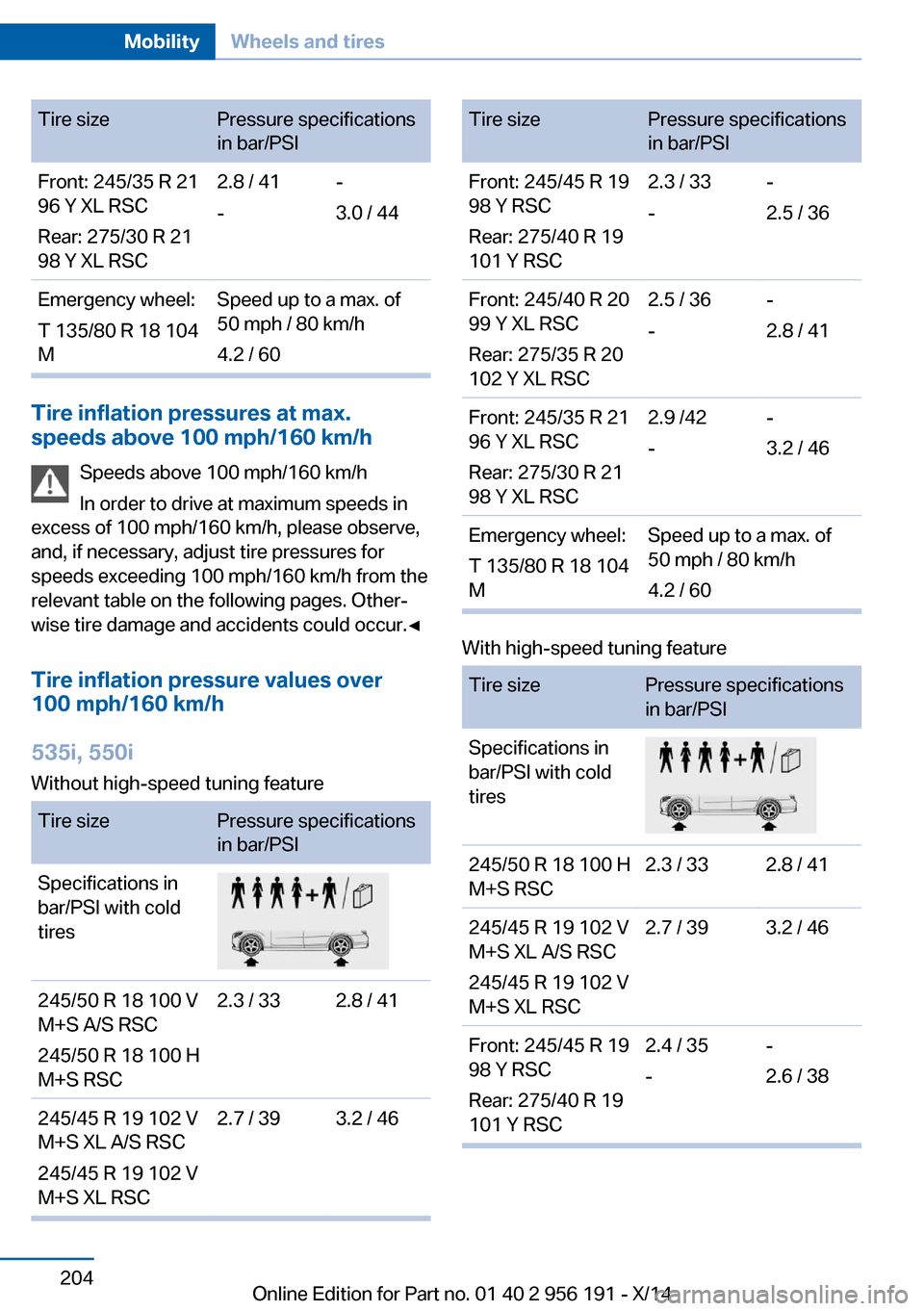
Tire sizePressure specifications
in bar/PSIFront: 245/35 R 21
96 Y XL RSC
Rear: 275/30 R 21
98 Y XL RSC2.8 / 41
--
3.0 / 44Emergency wheel:
T 135/80 R 18 104
MSpeed up to a max. of
50 mph / 80 km/h
4.2 / 60
Tire inflation pressures at max.
speeds above 100 mph/160 km/h
Speeds above 100 mph/160 km/h
In order to drive at maximum speeds in
excess of 100 mph/160 km/h, please observe,
and, if necessary, adjust tire pressures for
speeds exceeding 100 mph/160 km/h from the
relevant table on the following pages. Other‐
wise tire damage and accidents could occur.◀
Tire inflation pressure values over
100 mph/160 km/h
535i, 550i
Without high-speed tuning feature
Tire sizePressure specifications
in bar/PSISpecifications in
bar/PSI with cold
tires245/50 R 18 100 V
M+S A/S RSC
245/50 R 18 100 H
M+S RSC2.3 / 332.8 / 41245/45 R 19 102 V
M+S XL A/S RSC
245/45 R 19 102 V
M+S XL RSC2.7 / 393.2 / 46Tire sizePressure specifications
in bar/PSIFront: 245/45 R 19
98 Y RSC
Rear: 275/40 R 19
101 Y RSC2.3 / 33
--
2.5 / 36Front: 245/40 R 20
99 Y XL RSC
Rear: 275/35 R 20
102 Y XL RSC2.5 / 36
--
2.8 / 41Front: 245/35 R 21
96 Y XL RSC
Rear: 275/30 R 21
98 Y XL RSC2.9 /42
--
3.2 / 46Emergency wheel:
T 135/80 R 18 104
MSpeed up to a max. of
50 mph / 80 km/h
4.2 / 60
With high-speed tuning feature
Tire sizePressure specifications
in bar/PSISpecifications in
bar/PSI with cold
tires245/50 R 18 100 H
M+S RSC2.3 / 332.8 / 41245/45 R 19 102 V
M+S XL A/S RSC
245/45 R 19 102 V
M+S XL RSC2.7 / 393.2 / 46Front: 245/45 R 19
98 Y RSC
Rear: 275/40 R 19
101 Y RSC2.4 / 35
--
2.6 / 38Seite 204MobilityWheels and tires204
Online Edition for Part no. 01 40 2 956 191 - X/14
Page 213 of 259
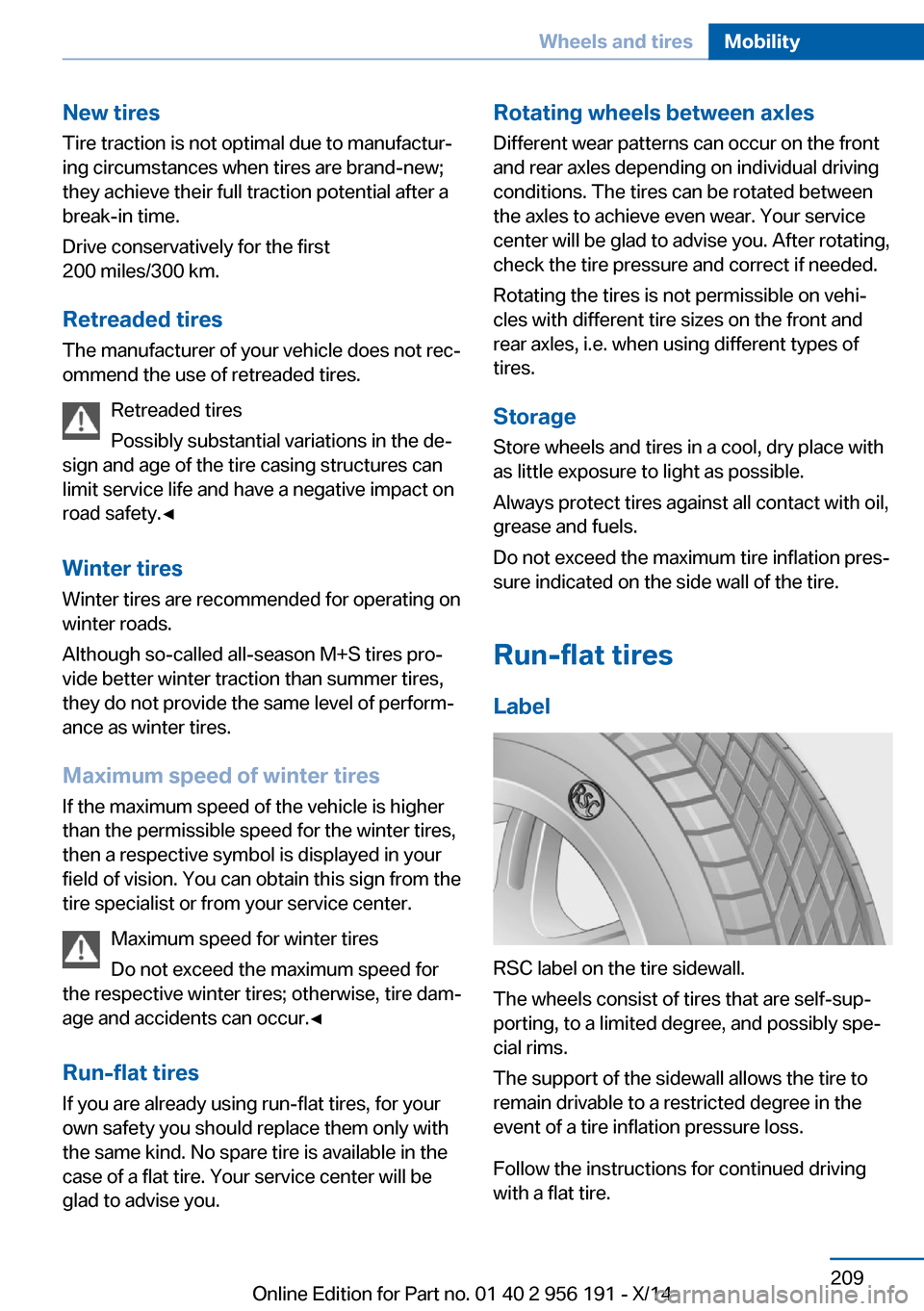
New tires
Tire traction is not optimal due to manufactur‐
ing circumstances when tires are brand-new;
they achieve their full traction potential after a
break-in time.
Drive conservatively for the first
200 miles/300 km.
Retreaded tires
The manufacturer of your vehicle does not rec‐
ommend the use of retreaded tires.
Retreaded tires
Possibly substantial variations in the de‐
sign and age of the tire casing structures can
limit service life and have a negative impact on
road safety.◀
Winter tires
Winter tires are recommended for operating on
winter roads.
Although so-called all-season M+S tires pro‐
vide better winter traction than summer tires,
they do not provide the same level of perform‐
ance as winter tires.
Maximum speed of winter tires If the maximum speed of the vehicle is higher
than the permissible speed for the winter tires,
then a respective symbol is displayed in your
field of vision. You can obtain this sign from the
tire specialist or from your service center.
Maximum speed for winter tires
Do not exceed the maximum speed for
the respective winter tires; otherwise, tire dam‐
age and accidents can occur.◀
Run-flat tires If you are already using run-flat tires, for your
own safety you should replace them only with
the same kind. No spare tire is available in the
case of a flat tire. Your service center will be
glad to advise you.Rotating wheels between axles
Different wear patterns can occur on the frontand rear axles depending on individual driving
conditions. The tires can be rotated between
the axles to achieve even wear. Your service
center will be glad to advise you. After rotating,
check the tire pressure and correct if needed.
Rotating the tires is not permissible on vehi‐
cles with different tire sizes on the front and
rear axles, i.e. when using different types of
tires.
Storage
Store wheels and tires in a cool, dry place with
as little exposure to light as possible.
Always protect tires against all contact with oil,
grease and fuels.
Do not exceed the maximum tire inflation pres‐
sure indicated on the side wall of the tire.
Run-flat tires
Label
RSC label on the tire sidewall.
The wheels consist of tires that are self-sup‐
porting, to a limited degree, and possibly spe‐
cial rims.
The support of the sidewall allows the tire to
remain drivable to a restricted degree in the
event of a tire inflation pressure loss.
Follow the instructions for continued driving
with a flat tire.
Seite 209Wheels and tiresMobility209
Online Edition for Part no. 01 40 2 956 191 - X/14
Page 252 of 259

Headlight flasher 78
Headlight glass 222
Headlights, care 234
Headlight washer system 78
Head restraints 53
Head restraints, front 59
Head restraints, rear 60
Head-up Display 100
Head-up Display, care 236
Heavy cargo, stowing 188
Height, vehicle 240
High-beam Assistant 104
High beams 78
High beams/low beams, refer to High-beam Assistant 104
Hill Descent Control HDC 135
Hills 186
Hill start assistant, refer to Drive-off assistant 133
Hints 6
Holder for beverages 179
Hood 212
Horn 14
Hotel function, tailgate 43
Hot exhaust system 184
HUD Head-up Display 100
Hydroplaning 185
I Ice warning, see External temperature warning 92
Icy roads, see External tem‐ perature warning 92
Identification marks, tires 206
Identification number, see ve‐ hicle identification num‐
ber 9
iDrive 18
Ignition key, refer to Remote control 34
Ignition off 70
Ignition on 70
Indication of a flat tire 111 , 113 Indicator and alarm lamps,
see Check Control 87
Indicator lamp, see Check Control 87
Individual air distribution 163
Individual settings, refer to Personal Profile 35
Inflation pressure, tires 202
Inflation pressure warning FTM, tires 110
Info display, refer to Com‐ puter 96
Initialization, Integral Active Steering 137
Initialize, Tire Pressure Moni‐ tor TPM 113
Initializing, Flat Tire Monitor FTM 110
Instrument cluster 84
Instrument cluster, electronic displays 84
Instrument display, multifunc‐ tional 85
Instrument lighting 105
Integral Active Steering 137
Integrated key 34
Integrated Owner's Manual in the vehicle 29
Intelligent Emergency Re‐ quest 228
Intelligent Safety 115
Intensity, AUTO pro‐ gram 163
Interior equipment 169
Interior lights 105
Interior lights via remote con‐ trol 38
Interior motion sensor 48
Interior rearview mirror, auto‐ matic dimming feature 63
Interior rearview mirror, man‐ ually dimmable 63
Interval display, service re‐ quirements 93 J
Jacking points for the vehicle jack 225
Joystick, Steptronic transmis‐ sion 81
Jump-starting 230
K
Key/remote control 34
Keyless Go, refer to Comfort Access 44
Key Memory, refer to Per‐ sonal Profile 35
Kickdown, Steptronic trans‐ mission 81
Knee airbag 107
L Lamp replacement, rear 224
Lane departure warning 127
Lane margin, warning 127
Language on Control Dis‐ play 99
Large tailgate via remote con‐ trol 38
Lashing eyes, securing cargo 188
LATCH child restraint sys‐ tem 66
Leather, care 234
LED front fog lights, bulb re‐ placement 224
LED headlights, Bulb replace‐ ment 224
LED light 224
LEDs, light-emitting di‐ odes 222
Length, vehicle 240
Letters and numbers, enter‐ ing 24
License plate lamp, bulb re‐ placement 224
Light alloy wheels, care 235 Seite 248ReferenceEverything from A to Z248
Online Edition for Part no. 01 40 2 956 191 - X/14
Page 256 of 259

Status information, iDrive 22
Status of Owner's Manual 6
Steering, Integral Active Steering 137
Steering wheel, adjusting 64
Steering wheel heating 64
Steering wheel memory 61
Steptronic Sport transmis‐ sion 82
Steptronic transmission 81
Stopping the engine 71
Storage compartment in the center console 179
Storage compartments 177
Storage compartments, loca‐ tions 177
Storage, tires 209
Storing the vehicle 236
Summer tires, tread 207
Sun visor 171
Supplementary text mes‐ sage 90
Surround View 152
Suspension settings 138
Switch for Dynamic Driving Control 138
Switch-on times, parked-car ventilation 168
Switch, refer to Cockpit 14
Symbols 6
Symbols in the status field 22
SYNC program, automatic cli‐ mate control 164
T Tachometer 91
Tail and brake lights 224
Tailgate, automatic 41
Tailgate closing 41
Tailgate, closing with no- touch activation 45
Tailgate, Emergency unlock‐ ing 44
Tailgate, hotel function 43 Tailgate, opening with no-
touch activation 45
Tail lights 224
Tail lights, bulb replace‐ ment 224
Technical changes, refer to Safety 7
Technical data 240
Telephone, see user's manual for Navigation, Entertain‐
ment and Communication
Temperature, automatic cli‐ mate control 163
Temperature display for ex‐ ternal temperature 92
Temperature, engine oil 91
Terminal, starting aid 230
Text message, supplemen‐ tary 90
Theft alarm system, refer to Alarm system 47
Thermal camera, see Night Vision 124
Thigh support 55
Through-loading system 174
Tilt alarm sensor 48
Time of arrival 97
Tire damage 207
Tire identification marks 206
Tire inflation pressure 202
Tire inflation pressure moni‐ tor, refer to FTM 110
Tire Pressure Monitor TPM 112
Tires, changing 208
Tires, everything on wheels and tires 202
Tires, run-flat tires 209
Tire tread 207
Tone, see user's manual for Navigation, Entertainment
and Communication
Tool 221
Top View 156
Total vehicle weight 241
Touchpad 21 Tow fitting 232
Towing 231
Tow lug, see tow fitting 232
Tow-starting 231
TPM Tire Pressure Moni‐ tor 112
Traction control 134
TRACTION, driving dynam‐ ics 134
TRACTION program, Dy‐ namic Driving Control 139
Transmission lock, electronic unlocking 83
Transmission, see Steptronic transmission 81
Transporting children safely 65
Tread, tires 207
Trip computer 97
Triple turn signal activa‐ tion 77
Trip odometer 92
Turning circle 240
Turning circle lines, rearview camera 154
Turn signals, operation 77
Turn signals, rear, bulb re‐ placement 224
U
Unintentional alarm 48
Units of measure 99
Universal remote control 169
Unlock button, Steptronic transmission 81
Unlocking/locking via door lock 39
Unlocking/locking with re‐ mote control 37
Unlocking, settings 46
Updates made after the edito‐ rial deadline 6
Upholstery care 235
USB interface 173 Seite 252ReferenceEverything from A to Z252
Online Edition for Part no. 01 40 2 956 191 - X/14